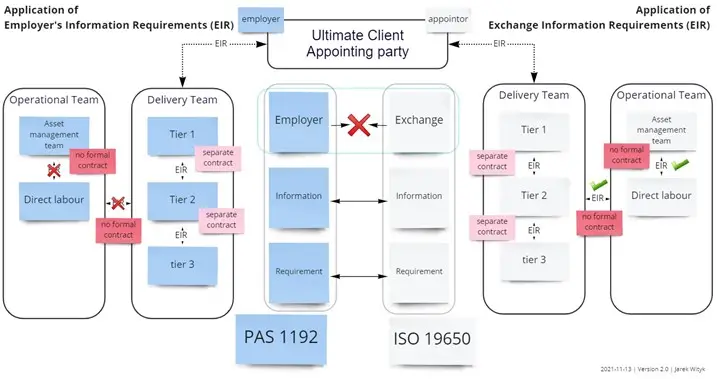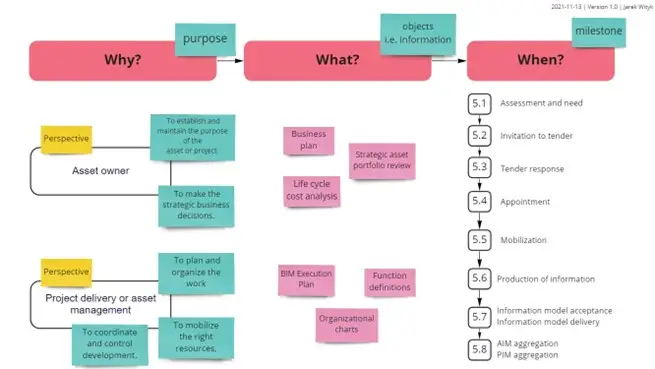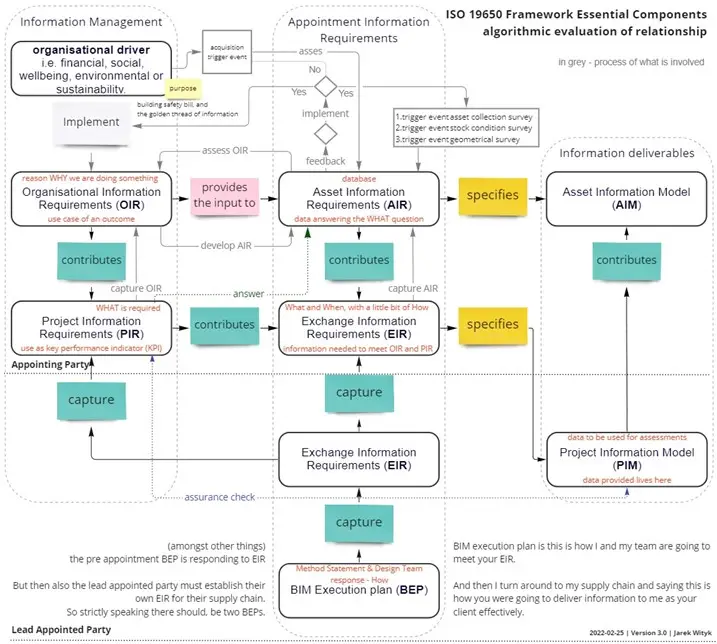Dictionary
Digital Construction (electrical)
term introduced first in PAS 1192 and updated in ISO 19650 framework, it depicts the process of specifying and delivery of project and asset information
forms a framework that supports informed and consistent decision making by project teams, at each work stage, helping to deliver agreed and reliable information.
Exchange Information Requirements (EIR) term introduced by BS EN 19650 replace the PAS 1192 term Employer Information Requirements (EIR) on all projects where BS EN ISO 19650 compliance is required.
The term introduced by ISO 19650 typically describes the Tier 1 Main Contractor.
breakdown structure to help plan the production of information
schedule of information containers and delivery dates, for a specific task team
An MPDT its old PAS 1192 term, the MPDT defines who produces what, when and to what level of detail.
The Exchange Information Requirements (EIR) term introduced by BS EN 19650 replaces the PAS 1192 term Employer Information Requirements (EIR) on all projects where BS EN ISO 19650 compliance is required.
As the AEC industry transitions from PAS 1192 to the BS EN 19650 Framework, the term Exchange Information Requirements (EIR) may cause some confusion. The Exchange Information Requirements (EIR) phrase, introduced on the 16th of January 2019 by the publication of BS EN 19650 Part 1 and Part 2 replaced the PAS 1192 term: Employer’s Information Requirements. Because both terms use the same acronym (the EIR), clarification is required.
Figure 1 illustrates the distinction between ’employer’ and ‘exchange’. While an employer’s information requirements and exchange information requirements are synonymous[1] In terms of semantics, the change is significant and impacts the meaning of information management (IM).

An employer is frequently mistranslated as employing people, leading to confusion. To avoid ambiguity, ISO 19650 includes a term that is easier to translate internationally; the relevant definitions are included in Table 1;
Evaluation of the terms suggests that using the term Exchange instead of Employer in the EIR phrase has an advantage in cases where information is required to be exchanged between different parts of an organization as demonstrated in Figure 2.
| Definitions | |
| employer | the individual or organization that employs others.[6] |
| EIR PAS 1192 | a document which defines standards and processes for the delivery of information required by the employer (ultimate client) as part of the project delivery process provided by the suppliers for the development of the project or operation of the existing asset.[7] |
| exchange | giving something to someone and receiving something in return.[6] |
| EIR ISO 19650 | specification for what, when, how and for whom accountable information which can be validated and be suitable for communication or processing in relation to an agreed instruction for the provision of such information relating to works, goods or services.[3] |
Figure 2 depicts the differences in applying EIR PAS 1192 vs ISO 19650. For example, Exchange Information Requirements (EIR) on the right-hand side of the diagram includes information exchanged between an asset management team and a direct labour team or between different parts of a multidisciplinary organization, even if formal contracts are not established.
While in the same situation, the term Employer Information Requirement is far less appropriate, especially when applied to international standards.
Thus, the UK, keen to retain the deeply integrated EIR acronym in the BIM language, chose the term ‘exchange,’ which seemed to be a good fit.[2]

The diagram depicts an analysis of the use of Employer vs Exchange Information Requirements.
Now the application of the term Exchange Information Requirements (EIR) has been evaluated, a question may be raised as to what EIR means. This question must be answered to ascertain how and when information is exchanged.
The information requirements for the asset’s delivery or operational phase include the following: organizational, asset, and project information requirements – OIR + AIR + PIR
Through sets of exchange information requirements (EIRs), the Appointing Party shall provide all asset and project information necessary for asset management and project delivery. The information should be incorporated into project-related appointments or instructions and distributed throughout the supply chain.[3]
The EIR includes three main areas:
- Technical, for example, software platforms, level of need definitions.
- Management, for example, details of management techniques to be used on a project
- Commercial, for example, details of BIM Model deliverables, scheduling of data transmission, and definitions of information purposes.[4]
The task teams can only supply the asset and project information if the appointing party have explicitly stated their expectations and requirements in advance. Thus, Organizational Information Requirements (OIR) and Asset Information Requirements (AIR) are crucial to establishing EIR.
Approach to information exchange
The importance of a lean approach is emphasised by BS EN ISO 19650 1:2018, which states that the minimum amount of information necessary to comply with each relevant obligation, including information requested by other appointed parties, should be the level of information required. Anything more than this bare minimum is a waste.[3],p.23. According to the BS EN ISO 19650 Framework, the lean process of specifying requirements shall be based on the three principles illustrated in Figure 3, for example, the deliverable purpose (why), shall be relevant to the point of view of the specific project team member perspective.
However, one must bear in mind that the purpose does not imply ownership of the deliverables, who performs the work, or how the work is performed.[5], p.9 Table 1

By referencing the BS EN ISO 19650 Part 2 and Part 3 information management process milestones, the importance of considering when and what type of information may be required is demonstrated in Figure 3.
Analysis of information exchange principles
To answer the research sub questions the author examined in detail the relationship of the OIR, AIR, PIR, EIR, AIM, PIM, BEP, CDE, MIDP, and TIDP – the Framework Essential Components (FEC) of the ISO 19650 Framework. Table 2 summarises the context and areas of consideration for the FEC evaluation.
Table 2 Case Study FEC Relationship analysis
Why is information exchanged? | |
context | areas of consideration |
Reference: BS EN 17412-1 2020 clause 6.1 | |
purpose | to produce, manage and exchange project information during the appointment to ensure that all identified purposes are met, the level of information need for all identified objects should be combined. |
evidence of the objective (strategic) | can prospective delivery team manage project information in line with information requirements |
delivery tool (technical) | use of software applications establish needs |
Reference: ISO 19650 | |
Appointing Party Asset Operation | intended use informed decisions maintenance planning |
What type of information is exchanged? | |
Reference: BS EN ISO 19650 | |
Appointment requirements | OIR, AIR, PIR, EIR, AIM, PIM, Security Information Requirements, BIM Protocol, Trigger Events |
Design Team Response | BEP (pre-appointment), BEP (post appointment), MIDP, TIDP |
Reference: (Gingold et al., 2009) | |
Dependencies | Project dependent, team dependent, software dependent |
When is information exchanged? | |
Reference: ISO 19650 Part 2 & 3 | |
Information management | Information activities from 5.1 to 5.8 |
What amount of information is exchanged? | |
Reference: BS EN 17412-1 2020 | |
Level of information need | At different milestones, e.g. especially in the early phase, the actor responsible of delivering specified level of information need might not be specified. The level of information need does not specify: the purposes, information delivery milestones, the actor, the objects within a breakdown structure Different actors can be responsible for different level of information need at the same information delivery milestone to fulfil the same purpose. The same level of information need can be required by different actors at the same milestone to fulfil different purposes. Different level of information need can be required by different actors at the same milestone to fulfil the same purpose. specific level of information need at agreed information delivery milestone can be required without specifying who needs to deliver it. |
Reference: BS EN ISO 29481-1: 2016, clause 4.5 | |
Level of detail | level of detail provided to be driven by the life cycle stage |
Who is exchanging the information | |
Reference: ISO 19650, UK BIM Framework Information Protocol to support BS EN ISO 19650-2, NEC4 Practice Note 6, PAS 1192 | |
Who? | Project team, Delivery Team, Task Teams, Appointing party, Lead appointed party, Appointed party, supplier, employer, appointor, appointee, Tier 0 and below (see Figure 5‑7) |
During the analysis of the FEC and areas of consideration depicted in Table 3, I studied areas, such as the ability to deliver, manage and exchange information in line with information requirements, the use of software, intended use, dependency of information activities the purposes, milestones, the actor, and the objects within a breakdown structure. For example, different actors can be responsible for different levels of information at the same information delivery milestone to fulfil the same purpose, or vice versa. And at different milestones, especially in the early phase, the actor responsible of delivering a specified level of information need might not be available. .[5]. I pondered the question as to why information is exchanged and what acts as the initial trigger, or driver, of the process. I then derived with a new term ‘organizational driver,’ used as the most appropriate to describe the initial component of the information exchange sequence of steps and actions involved in the component’s exchange. The algorithmic representation of the analytical process is depicted in Figure 4.

The Figure 4 diagram portrays the steps and reasons for information exchange; this evaluation serves as a foundation for further validation and analysis.
[1] British Standards Institution, 2019b. Transition guidance to BS EN ISO 19650. p/15
[2] Churcher, D. (2021). email to: Jarek Wityk, subject: Exchange Information Requirements (EIR).
[3] British Standards Institution, 2018. BS EN ISO 19650-1:2018 Organization and digitization of information about buildings and civil engineering works, including building information modelling (BIM) – Information management using building information modelling Part 1: Concepts and principles.
[4] EU BIM Task Group, 2017.p. 64
[5] British Standards Institution, 2020a. BS EN 17412-1:2020_Building Information Modelling-Level of Information Need.
[6] Cambridge English Dictionary, n.d. Meaning of an employer in English [WWW Document]. (accessed 11.13.21a).
[7] British Standards Institution, 2016a. BS 1192:2007+A2:2016 Collaborative production of architectural, engineering and construction information-Code of practice, A2 ed.

